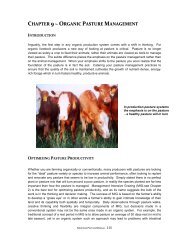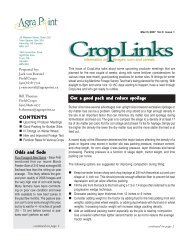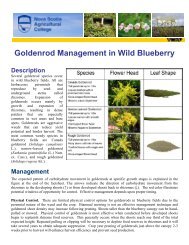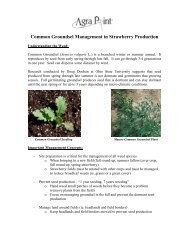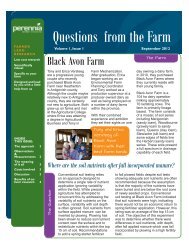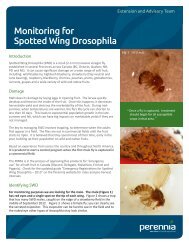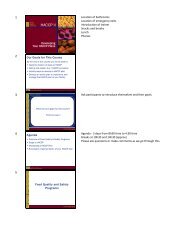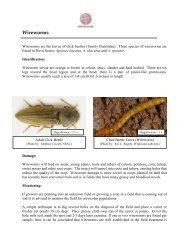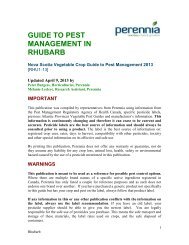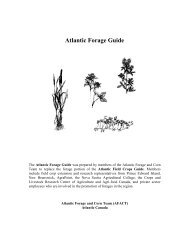Reducing Spray Drift - Perennia
Reducing Spray Drift - Perennia
Reducing Spray Drift - Perennia
Create successful ePaper yourself
Turn your PDF publications into a flip-book with our unique Google optimized e-Paper software.
<strong>Reducing</strong> <strong>Spray</strong> <strong>Drift</strong><br />
What is <strong>Spray</strong> <strong>Drift</strong>?<br />
<strong>Spray</strong> drift is the movement of pesticide spray droplets away from the intended target site. This is<br />
generally caused by air movement, low humidity or high temperatures.<br />
The loss of pesticide due to spray drift is a major concern from an environmental perspective,<br />
maintaining effective pest control and for maximizing the effect of input dollars spent on farm.<br />
<strong>Spray</strong> <strong>Drift</strong> Effect on the Environment<br />
Pesticides are chemicals designed to kill crop pests. When used properly there is a relatively low<br />
risk to applicators, the crop and the environment. However, spray drift can cause unintended<br />
harm to sensitive organisms and eco-systems away from the target site. Therefore, it is critical to<br />
minimize drift to limit the introduction of pesticides into water systems, sensitive crops,<br />
landscapes and residential areas.<br />
All pesticides are different and have different effects on sensitive areas. The majority of the time,<br />
the impact of spray drift is negligible. However, producers must be diligent and prevent spray<br />
drift in all situations to prevent possible larger environmental impacts off site.<br />
Farmers should take proper measures in communicating and educating about their farm practices<br />
to inform neighbors and public building owners. The majority of concerns regarding pesticide<br />
application are on spray drift. Other than communication and education other actions the farmer<br />
can undertake are the development of a drift reduction plan and following best management<br />
practices.<br />
<strong>Spray</strong> <strong>Drift</strong> Effect on Pest Control<br />
It is important to minimize spray drift from a pest control perspective. As spray drift increases,<br />
the amount of product that reaches the target pest decreases. This can result in a decreased level<br />
of pest control which could lead to a negative effect on crops yields. As well, time and energy is<br />
wasted by the producer in applying a product that doesn’t adequately reach the target pest.<br />
Another concern with a decreased amount of product reaching the target pest is the selection<br />
pressure this puts on the pest. It is well documented that if pesticides are used repeatedly,<br />
especially on pests that have multiple generations per year, pesticide tolerance can develop. This<br />
can be hastened with lower pesticide amounts reaching the target pests allowing more pests to<br />
survive. It is critically important, if a producer feels they need to apply a pesticide that the<br />
intended product amount reaches the target pest.<br />
What Affects <strong>Spray</strong> <strong>Drift</strong>?<br />
There are several factors that affect spray drift and the distance droplets will travel.
Droplet Size<br />
The smaller the droplet size the greater the impact of wind speed. Larger droplets have more<br />
weight and drop faster and are not as affected by wind speeds. Small droplets can stay in the air<br />
for extended periods of time making them more prone to drift. Droplet size is mainly affected by<br />
the nozzle type and orifice size as well as the operating pressure. As the operating pressure<br />
increases droplet size decreases. As well as the nozzle orifice size decreases, so does the droplet<br />
size. Try to use nozzle types and operating pressures that give larger droplet sizes.<br />
Boom Height<br />
The higher the boom height, the greater the chance for spray drift. The simple lowering of the<br />
boom will decrease exposure of droplets to wind. Moving from an 80° nozzle to a 110° nozzle<br />
will allow the producer to lower the boom by 3-4inches.<br />
Wind Speed<br />
Obviously wind speed is one of the biggest factors with regard to spray drift. Greater than<br />
20km/hr is a high risk for spray drift with any droplet size. It is advisable to cease application<br />
until after wind speeds have decreased.<br />
Dead calm conditions are also not ideal conditions for spraying. Smaller droplets can remain in<br />
the air for long periods of time then drift sometime later if winds arise. Applicators must pay<br />
attention when these conditions are present.<br />
Temperature and Humidity<br />
High temperatures, greater than 20 degrees C, cause drift through increased evaporation and<br />
volatilization of the pesticide. Low relative humidity combined with low wind, will keep small<br />
droplets in the air for long periods of time as well. These factors will increase the chance of<br />
pesticides moving off size.<br />
<strong>Spray</strong>er Speed<br />
The speed of the tractor and spray can impact spray drift by creating convection currents around<br />
the tractor. There is a greater affect on spray drift at higher ground speeds.<br />
Methods to Reduce <strong>Spray</strong> <strong>Drift</strong> and its Impact<br />
The methods that we can use to reduce spray drift and its impacts:<br />
(1) Always spray down wind of environmentally sensitive areas (water ways, sensitive crops, and<br />
residential areas)<br />
(2) Create a buffer zone around sensitive areas. An area where no pesticides are applied,<br />
between the crop and the sensitive area. The size of this area will vary depending on the crop, the<br />
pesticide and the nature of the sensitive area. Regulatory officials are currently working on the<br />
guidelines to further define this zone.<br />
(3) Always spray when wind speeds are below the maximum specifications for the nozzle type<br />
you are using.<br />
(4) Try not spray when temperatures are above 20 degrees C or when relative humidity is low<br />
(generally not a concern in Nova Scotia)<br />
(5) Always spray within the pressure and water volume specifications of the nozzle you are using.<br />
<strong>Reducing</strong> <strong>Spray</strong> <strong>Drift</strong> Page 2 of 3
(6) Increase the spray angle of your nozzles, thus decreasing boom height. (i.e. 110 degree angle<br />
nozzles operate ideally at a height of 15 – 18 inches above the target canopy, 80 degree nozzles<br />
operate ideally 17 – 19 inches above the target canopy)<br />
(7) Use shield guards on spray booms.<br />
(8) Plant wind rows in large open fields to reduce wind speeds in field and limit drift movement<br />
off site.<br />
(9) Use drift reduction nozzles: These nozzles produce larger more uniform spray droplets at<br />
higher pressures.<br />
Air assist nozzles (Turbo drop, AI Teejet) These nozzles contain a pressure reduction<br />
chamber with a narrow port used to draw air into the pressure chamber. The air and the liquid are<br />
mixed like a water aspirator. As the liquid is discharged from the nozzle tip droplets filled with<br />
air are produced. After leaving the nozzle air inside the droplets expands making the droplets<br />
larger and causes and increase in velocity of the droplet. The droplets also shatter on contact with<br />
the target thus causing better coverage. The larger faster moving droplets greatly reduce drift<br />
potential.<br />
Low drift nozzles (<strong>Drift</strong> Guard, Rain Drop, Turbo Teejet)<br />
These nozzles have a pre-orifice chamber at the tip that slows down the liquid creating a more<br />
uniform spray pattern and larger droplets than a conventional flat fan nozzle at the same operating<br />
pressure. Some of these brands also have a wide pressure operating range (15-90 psi) (turbo<br />
teejet)<br />
It is always very important to understand the limitations of the nozzle type you are using. Finally,<br />
it is critical to understand the pesticide you are spraying. All pesticides have specific application<br />
instructions on their labels. Some pesticides can have a much greater impact on non target<br />
organisms than others, so special drift reduction and mitigation measures may be required for that<br />
specific product on its’ label. As always, fully read and understand the label of the product<br />
you are applying.<br />
Additional Resources:<br />
http://www.gov.ns.ca/enla/pests/<br />
http://www.griffin.peachnet.edu/caes/soybeans/2005guide/nozzles.pdf<br />
http://www.teejet.com/MS/TeeJet/support2.asp?ID=86<br />
http://www.stopsoybeanrust.com/images/TJusergde.pdf<br />
For more information, please contact:<br />
Peter Burgess<br />
Integrated Pest Management Co-ordinator<br />
(902) 896-0277<br />
AgraPoint’s Ag Info Centre<br />
1-866-606-4636<br />
© AgraPoint International Inc.<br />
<strong>Reducing</strong> <strong>Spray</strong> <strong>Drift</strong> Page 3 of 3



